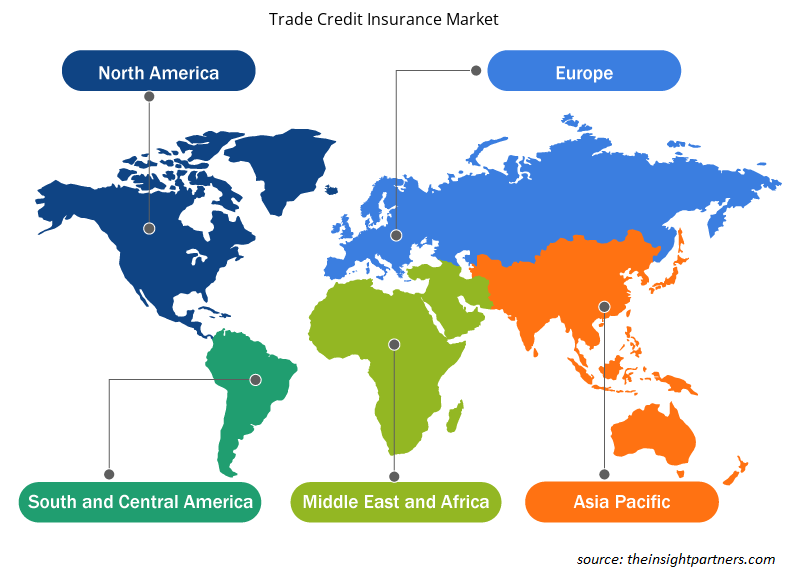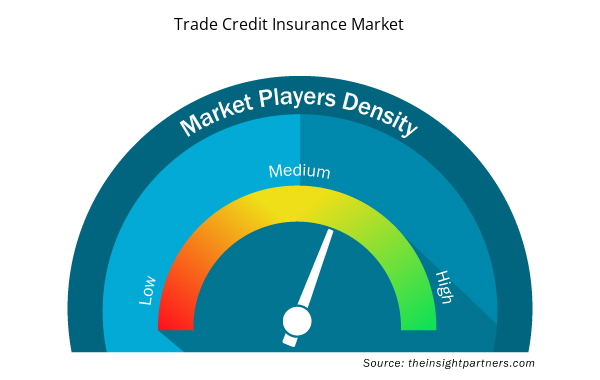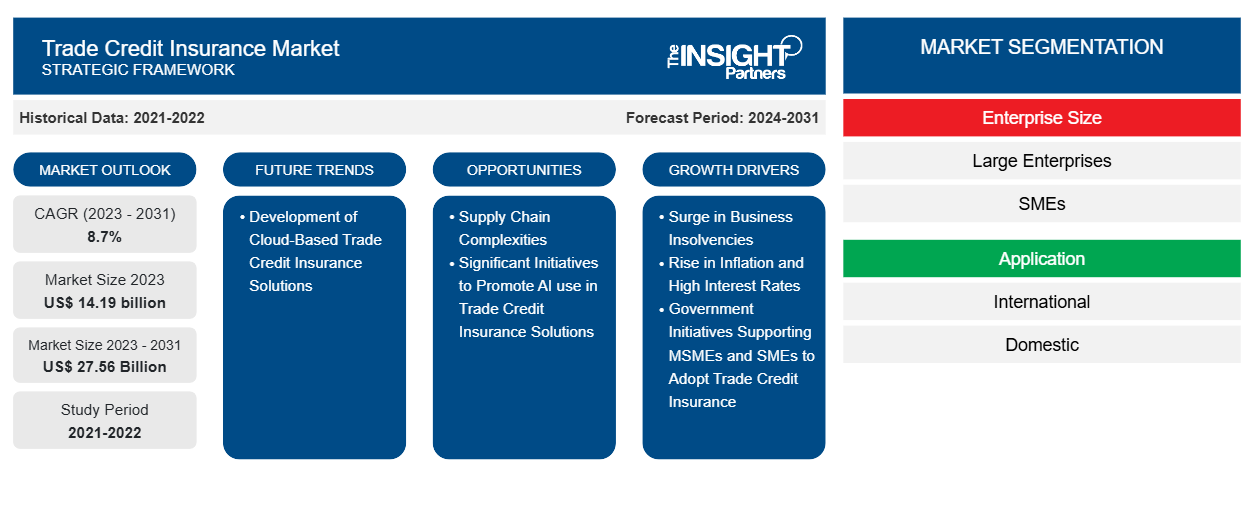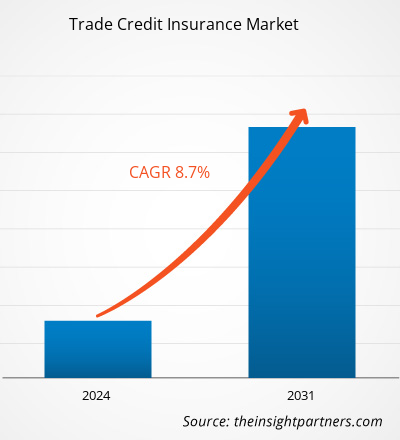貿易信用保険の市場規模は、2023年の141億9,000万米ドルから2031年には275億6,000万米ドルに達すると予測されています。市場は2023年から2031年の間に8.7%のCAGRを記録すると予想されています。クラウドベースの貿易信用保険ソリューションの開発は、市場の主要なトレンドの1つであり続けると思われます。
貿易信用保険市場分析
貿易信用保険は、未払い請求書に関連する損失から企業を保護し、企業の発展を保護するために用いられる重要な信用リスク管理ポリシーです。このポリシーは、支払い不能、景気後退、破産、その他の問題による請求書の支払いを保険会社に支援します。政治的混乱や不利な事業展開は、国境を越えた取引に従事する企業にとってリスクの増大につながる可能性があります。これが、世界中で貿易信用保険ソリューションを採用する大きな原動力となっています。
貿易信用保険市場の概要
貿易信用保険は、IT・通信、小売、製造、食品・飲料、その他の業界で、財務リスクから身を守るために広く使用されています。技術の進歩、インフレの上昇、サプライチェーンに関連する複雑さの急増、政府の好ましい取り組みが、貿易信用保険市場の成長を後押ししています。中小企業、中小零細企業、大企業における収益を適切に維持するための貿易信用保険の需要の高まりは、貿易信用保険市場全体の成長に大きく貢献しています。
要件に合わせてレポートをカスタマイズする
このレポートの一部、国レベルの分析、Excelデータパックなど、あらゆるレポートを無料でカスタマイズできます。また、スタートアップや大学向けのお得なオファーや割引もご利用いただけます。
- このレポートの主要な市場動向を入手してください。この無料サンプルには、市場動向から見積もりや予測に至るまでのデータ分析が含まれます。
貿易信用保険市場の推進要因と機会
中小企業の貿易信用保険導入を支援する政府の取り組み
保険は、金融リスクを軽減し、支払い不履行などのリスクを吸収するため、中小零細企業(MSME)および中小企業(SME)にとって非常に重要です。地政学的問題、景気低迷、サプライチェーンの不安定性、インフレなどの要因の高まりにより、世界中の輸出に伴うリスクが高まっており、シームレスな支払いを行うためにMSMEの間で貿易信用保険の需要が高まっています。さらに、過去の傾向から、インドのMSMEとSMEの大部分は保険の必要性を理解していないため、無保険であることが示されています。彼らは、買い手または銀行が要求した場合にのみ保険を購入するため、金融リスクに対して脆弱です。これはまた、政府がMSMEとSMEが貿易信用保険を採用して、金融リスクや支払い不履行からビジネスを保護するための支援を行うイニシアチブを取ることを奨励しています。たとえば、インド保険規制開発庁(IRDAI)の2021年貿易信用保険ガイドラインは、MSMEとSMEが貿易信用保険を採用して、変化する保険リスクからビジネスを保護することを支援しています。ガイドラインには以下が含まれます。
- 政府と市場関係者は、貿易信用保険事業の持続的かつ強力な発展を促進します。
- 損害保険会社は、サプライヤー、認可銀行、その他の金融機関に貿易信用保険を提供し、ビジネスリスクの管理と新規市場への参入を支援します。貿易信用保険は、企業が貿易金融ポートフォリオに関連する不払いリスクを管理することをサポートします。
- 損害保険会社は、中小企業や中小零細企業の事業を改善し、進化する保険リスクから身を守るカスタマイズされた貿易信用保険を提供しています。
したがって、MSME と SME が財務リスクからビジネスを保護するために貿易信用保険を導入することを支援する有利なガイドラインやその他の政府の取り組みが、市場の成長を促進します。
サプライチェーンの複雑さ
電子商取引業界の拡大は、新しいサプライチェーンの取り決めに対する需要の増加につながります。新しいサプライチェーンの取り決めの開発はサプライチェーンの複雑さを高め、ビジネスプロセスを合理化するために電子商取引における貿易信用保険の需要が高まります。その結果、市場プレーヤーは電子商取引業界向けの新しい範囲の貿易信用保険サービスを開発しています。たとえば、2024年3月、アリアンツトレードはB2B電子商取引活動向けのアリアンツトレード支払いサービスを開始しました。アリアンツトレードペイは、アリアンツトレードの金融機関パートナーを通じて、詐欺モジュール、デジタルバイヤーオンボーディングソリューション、貿易信用保険保護、インスタントファイナンスソリューションなど、さまざまなサービスを提供する支払いソリューションです。アリアンツトレードペイは、電子商取引エコシステムに柔軟性、セキュリティ、シンプルさ、競争力を提供し、複雑なサプライチェーンを管理するために電子商取引業界での採用が増加しています。
さまざまな国が多極システムを採用しており、リショアリングまたはフレンドショアリング生産のために先進的な市場メーカーの存在が必要です。これにより、世界中の顧客のニーズを満たすために、並列および複数のサプライチェーンと生産施設の移転の需要が生まれました。その結果、中間財のサプライチェーン活動の減少は、特に中間財の貿易に関連する複雑さの増加につながります。たとえば、2023年10月に発表された世界貿易機関(WTO)のデータによると、中間財のサプライチェーン活動は2023年上半期に48.5%減少しました。これは、過去3年間の平均51.0%から減少しました。したがって、サプライチェーンの複雑さにより、取引先リスクに対する貿易信用保険保護の需要が高まり、予測期間中に貿易信用保険市場の成長に多くの機会が生まれると予想されます。
貿易信用保険市場レポートのセグメンテーション分析
貿易信用保険市場分析の導出に貢献した主要なセグメントは、企業規模、アプリケーション、およびエンドユーザーです。
- 企業規模に基づいて、貿易信用保険市場は大企業と中小企業に分かれています。大企業セグメントは2023年に大きな市場シェアを占めました。
- アプリケーションに基づいて、市場は国内と海外に分かれています。2023年には国際セグメントがより大きな市場シェアを占めました。
- エンドユーザー別に見ると、市場はエネルギー、自動車、航空宇宙、化学、金属、農業、食品・飲料、金融サービス、テクノロジー・通信、輸送、その他に分類されています。エネルギー分野は2023年に大きな市場シェアを占めました。
地域別貿易信用保険市場シェア分析
貿易信用保険市場レポートの地理的範囲は、主に北米、アジア太平洋、ヨーロッパ、中東およびアフリカ、南米および中米の 5 つの地域に分かれています。
2023年には、ヨーロッパが貿易信用保険の市場シェアを独占しました。2023年4月のアリアンツトレードレポートによると、ドイツの企業の76%が支払い遅延を経験しています。これらの支払い遅延は、サプライチェーンの複雑さと混乱により急増しています。さらに、同じ情報源によると、ドイツでは17,800件の企業倒産のうち22%以上が過剰債務と不十分な資本準備金によるものです。このように、支払い遅延と倒産率の上昇は、企業が財務リスクから身を守るために貿易信用保険の需要を高めるいくつかの要因です。企業間の貿易信用保険の需要の高まりは、保険会社がフランス全土で事業を拡大することを奨励しています。たとえば、アリアンツトレードが2023年11月に実施した調査によると、フランス企業の97%が顧客に支払い条件を提供しており、全体の平均期間は48日です。フランスには、Allianz Trade、COFACE SA、Atradius NV などの大手企業が多数存在しています。これらの企業は、支払いを頻繁に行うことで企業を支援し、中小企業に影響を与える支払い遅延の数を減らすことにも貢献しています。これらすべての要因が、フランスの貿易信用保険市場の成長に貢献しています。
貿易信用保険市場の地域別洞察
予測期間を通じて貿易信用保険市場に影響を与える地域的な傾向と要因は、Insight Partners のアナリストによって徹底的に説明されています。このセクションでは、北米、ヨーロッパ、アジア太平洋、中東、アフリカ、南米、中米にわたる貿易信用保険市場のセグメントと地理についても説明します。

- 貿易信用保険市場の地域別データを入手
貿易信用保険市場レポートの範囲
| レポート属性 | 詳細 |
|---|---|
| 2023年の市場規模 | 141億9000万米ドル |
| 2031年までの市場規模 | 275.6億米ドル |
| 世界のCAGR(2023年~2031年) | 8.7% |
| 履歴データ | 2021-2022 |
| 予測期間 | 2024-2031 |
| 対象セグメント | 企業規模別
|
| 対象地域と国 | 北米
|
| 市場リーダーと主要企業プロフィール |
|
貿易信用保険市場のプレーヤー密度:ビジネスダイナミクスへの影響を理解する
貿易信用保険市場は、消費者の嗜好の変化、技術の進歩、製品の利点に対する認識の高まりなどの要因により、エンドユーザーの需要が高まり、急速に成長しています。需要が高まるにつれて、企業は提供内容を拡大し、消費者のニーズを満たすために革新し、新たなトレンドを活用し、市場の成長をさらに促進しています。
市場プレーヤー密度とは、特定の市場または業界内で活動している企業または会社の分布を指します。これは、特定の市場スペースに、その市場規模または総市場価値に対してどれだけの競合相手 (市場プレーヤー) が存在するかを示します。
貿易信用保険市場で事業を展開している主要企業は次のとおりです。
- アリアンツ・トレード
- コファスSA
- アメリカン・インターナショナル・グループ
- チャブ株式会社
- QBE保険グループ株式会社
- エーオン
免責事項:上記の企業は、特定の順序でランク付けされていません。

- 貿易信用保険市場のトップキープレーヤーの概要を入手
貿易信用保険市場のニュースと最近の動向
貿易信用保険市場は、主要な企業出版物、協会データ、データベースなどの一次調査と二次調査を経て定性的および定量的データを収集することで評価されます。貿易信用保険市場の動向のいくつかを以下に示します。
- 世界的な信用保険会社であるコファスは、4月1日にニュージーランド準備銀行の承認を受け、ニュージーランドに支店を開設したと発表した。この新たな国への進出により、同グループの国際的なカバレッジがさらに強化される。(出典:コファス、プレスリリース、2024年4月)
- チャブは、保険金請求処理における生成 AI に関して、英国を拠点とするインシュアテック企業 Cytora と提携しました。この提携は、デジタル化プロセスを自動化することで、チャブの請求文書管理を変革することを目指しています。(出典: チャブ、プレスリリース、2024 年 3 月)
貿易信用保険市場レポートの対象範囲と成果物
「貿易信用保険市場の規模と予測(2021〜2031年)」レポートでは、以下の分野をカバーする市場の詳細な分析を提供しています。
- 貿易信用保険市場の規模と予測(世界、地域、国レベルで)
- 貿易信用保険市場の動向、推進要因、制約、主要な機会などの市場動向
- 詳細なPESTおよびSWOT分析
- 主要な市場動向、世界および地域の枠組み、主要プレーヤー、規制、最近の市場動向を網羅した貿易信用保険市場分析
- 貿易信用保険市場の市場集中、ヒートマップ分析、主要プレーヤー、最近の動向を網羅した業界の状況と競争分析
- 詳細な企業プロフィール
- 過去2年間の分析、基準年、CAGRによる予測(7年間)
- PEST分析とSWOT分析
- 市場規模価値/数量 - 世界、地域、国
- 業界と競争環境
- Excel データセット


- Artificial Intelligence in Defense Market
- Digital Language Learning Market
- Influenza Vaccines Market
- Smart Parking Market
- Lyophilization Services for Biopharmaceuticals Market
- Aircraft Wire and Cable Market
- Sexual Wellness Market
- Real-Time Location Systems Market
- Digital Pathology Market
- Tortilla Market

Report Coverage
Revenue forecast, Company Analysis, Industry landscape, Growth factors, and Trends

Segment Covered
This text is related
to segments covered.

Regional Scope
North America, Europe, Asia Pacific, Middle East & Africa, South & Central America

Country Scope
This text is related
to country scope.
よくある質問
The trade credit insurance market is expected to register an incremental growth value of US$ 13.37 billion during the forecast period
Large enterprises segment is expected to hold a major market share of trade credit insurance market in 2023
The global market size of trade credit insurance market by 2031 will be around US$ 27.56 billion
The United States is expected to hold a major market share of trade credit insurance market in 2023
Asia Pacific is expected to register highest CAGR in the trade credit insurance market during the forecast period (2023-2031)
United States, China, and Rest of Europe are expected to register high growth rate during the forecast period
BEA, BBC Bircher AG, GEZE GmbH, Hotron Ltd, MS SEDCO, OPTEX TECHNOLOGIES INC, Pepperl+Fuchs SE, Nabtesco Corp, Ningbo VEZE Automatic Door Co., Ltd., and TORMAX USA Inc. are the key market players expected to hold a major market share of trade credit insurance market in 2023
Development of cloud-based trade credit insurance solutions are anticipated to play a significant role in the trade credit insurance market in the coming years.
Surge in business insolvencies, rise in inflation and high interest rates, and government initiatives supporting MSMEs and SMEs to adopt trade credit insurance are the major factors that propel the trade credit insurance market.
The estimated global market size for the trade credit insurance market in 2023 is expected to be around US$ 14.19 billion
Trends and growth analysis reports related to Banking, Financial Services, and Insurance : READ MORE..
The List of Companies - Trade Credit Insurance Market
- Allianz Trade
- COFACE SA
- American International Group Inc
- Chubb Ltd
- QBE Insurance Group Ltd
- Aon Plc
- Credendo
- Atradius NV
- Zurich Insurance Group AG
- Great American Insurance Company
The Insight Partners performs research in 4 major stages: Data Collection & Secondary Research, Primary Research, Data Analysis and Data Triangulation & Final Review.
- Data Collection and Secondary Research:
As a market research and consulting firm operating from a decade, we have published and advised several client across the globe. First step for any study will start with an assessment of currently available data and insights from existing reports. Further, historical and current market information is collected from Investor Presentations, Annual Reports, SEC Filings, etc., and other information related to company’s performance and market positioning are gathered from Paid Databases (Factiva, Hoovers, and Reuters) and various other publications available in public domain.
Several associations trade associates, technical forums, institutes, societies and organization are accessed to gain technical as well as market related insights through their publications such as research papers, blogs and press releases related to the studies are referred to get cues about the market. Further, white papers, journals, magazines, and other news articles published in last 3 years are scrutinized and analyzed to understand the current market trends.
- Primary Research:
The primarily interview analysis comprise of data obtained from industry participants interview and answers to survey questions gathered by in-house primary team.
For primary research, interviews are conducted with industry experts/CEOs/Marketing Managers/VPs/Subject Matter Experts from both demand and supply side to get a 360-degree view of the market. The primary team conducts several interviews based on the complexity of the markets to understand the various market trends and dynamics which makes research more credible and precise.
A typical research interview fulfils the following functions:
- Provides first-hand information on the market size, market trends, growth trends, competitive landscape, and outlook
- Validates and strengthens in-house secondary research findings
- Develops the analysis team’s expertise and market understanding
Primary research involves email interactions and telephone interviews for each market, category, segment, and sub-segment across geographies. The participants who typically take part in such a process include, but are not limited to:
- Industry participants: VPs, business development managers, market intelligence managers and national sales managers
- Outside experts: Valuation experts, research analysts and key opinion leaders specializing in the electronics and semiconductor industry.
Below is the breakup of our primary respondents by company, designation, and region:

Once we receive the confirmation from primary research sources or primary respondents, we finalize the base year market estimation and forecast the data as per the macroeconomic and microeconomic factors assessed during data collection.
- Data Analysis:
Once data is validated through both secondary as well as primary respondents, we finalize the market estimations by hypothesis formulation and factor analysis at regional and country level.
- Macro-Economic Factor Analysis:
We analyse macroeconomic indicators such the gross domestic product (GDP), increase in the demand for goods and services across industries, technological advancement, regional economic growth, governmental policies, the influence of COVID-19, PEST analysis, and other aspects. This analysis aids in setting benchmarks for various nations/regions and approximating market splits. Additionally, the general trend of the aforementioned components aid in determining the market's development possibilities.
- Country Level Data:
Various factors that are especially aligned to the country are taken into account to determine the market size for a certain area and country, including the presence of vendors, such as headquarters and offices, the country's GDP, demand patterns, and industry growth. To comprehend the market dynamics for the nation, a number of growth variables, inhibitors, application areas, and current market trends are researched. The aforementioned elements aid in determining the country's overall market's growth potential.
- Company Profile:
The “Table of Contents” is formulated by listing and analyzing more than 25 - 30 companies operating in the market ecosystem across geographies. However, we profile only 10 companies as a standard practice in our syndicate reports. These 10 companies comprise leading, emerging, and regional players. Nonetheless, our analysis is not restricted to the 10 listed companies, we also analyze other companies present in the market to develop a holistic view and understand the prevailing trends. The “Company Profiles” section in the report covers key facts, business description, products & services, financial information, SWOT analysis, and key developments. The financial information presented is extracted from the annual reports and official documents of the publicly listed companies. Upon collecting the information for the sections of respective companies, we verify them via various primary sources and then compile the data in respective company profiles. The company level information helps us in deriving the base number as well as in forecasting the market size.
- Developing Base Number:
Aggregation of sales statistics (2020-2022) and macro-economic factor, and other secondary and primary research insights are utilized to arrive at base number and related market shares for 2022. The data gaps are identified in this step and relevant market data is analyzed, collected from paid primary interviews or databases. On finalizing the base year market size, forecasts are developed on the basis of macro-economic, industry and market growth factors and company level analysis.
- Data Triangulation and Final Review:
The market findings and base year market size calculations are validated from supply as well as demand side. Demand side validations are based on macro-economic factor analysis and benchmarks for respective regions and countries. In case of supply side validations, revenues of major companies are estimated (in case not available) based on industry benchmark, approximate number of employees, product portfolio, and primary interviews revenues are gathered. Further revenue from target product/service segment is assessed to avoid overshooting of market statistics. In case of heavy deviations between supply and demand side values, all thes steps are repeated to achieve synchronization.
We follow an iterative model, wherein we share our research findings with Subject Matter Experts (SME’s) and Key Opinion Leaders (KOLs) until consensus view of the market is not formulated – this model negates any drastic deviation in the opinions of experts. Only validated and universally acceptable research findings are quoted in our reports.
We have important check points that we use to validate our research findings – which we call – data triangulation, where we validate the information, we generate from secondary sources with primary interviews and then we re-validate with our internal data bases and Subject matter experts. This comprehensive model enables us to deliver high quality, reliable data in shortest possible time.


 このレポートの無料サンプルを入手する
このレポートの無料サンプルを入手する